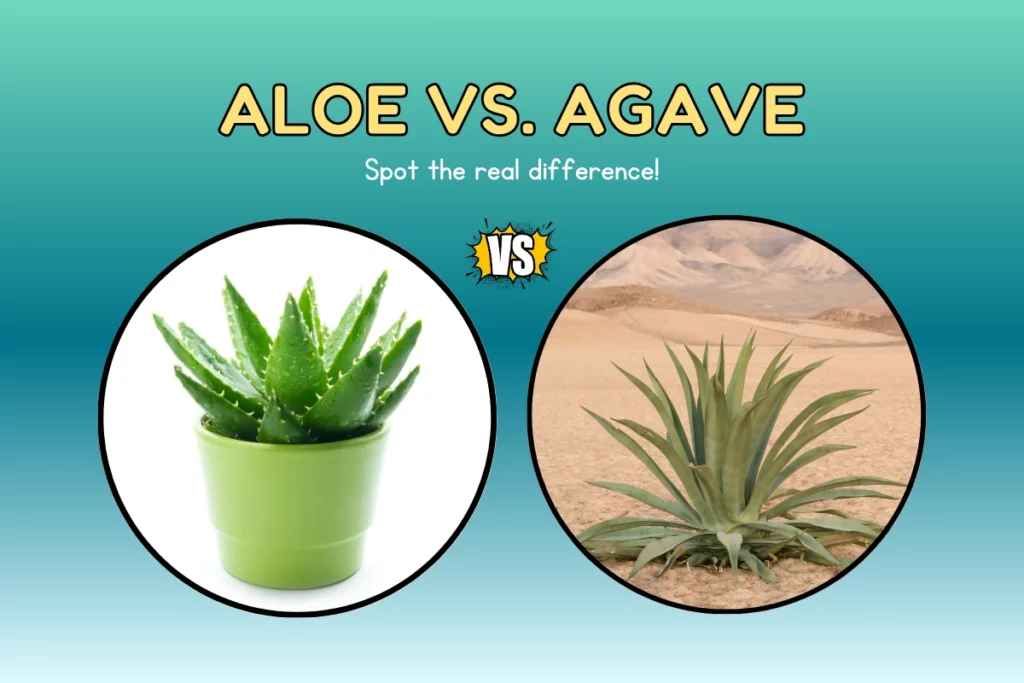
Aloe and agave plants often look so similar that even experienced gardeners sometimes confuse them. Both have thick, spiky leaves and thrive in hot, dry climates, but that’s where the similarities end. If you’re not sure which one you’ve got, the differences matter more than you think. In this guide, we’ll break down the key traits that separate aloe vs. agave, show you common species of each, and share simple tools to help you identify them accurately.
Is Agave Aloe?
The short answer is NO. Although they share a similar appearance, with rosette shapes, thick leaves, and spines, agave and aloe belong to entirely different plant families. Agave is part of the Asparagaceae family, while aloe belongs to the Asphodelaceae. They’re not closely related at all. Still, the confusion makes sense. What makes them easy to confuse?
- Both are drought-tolerant succulents with pointed leaves
- Both grow in rosettes (circular leaf formations)
- Both can have toothed or spiny leaf edges
- Some agave species have smooth leaf surfaces, just like aloe
But their differences become clear once you know what to look for. Let’s reveal them in the next section. Stay tuned!
Aloe vs. Agave: Key Differences
Although they share a similar look, aloe and agave are very different once you know what to look for. Below is a detailed breakdown of how they compare in texture, structure, biology, and use.
Overview Table
| Feature | Aloe | Agave |
| Plant family | Asphodelaceae | Asparagaceae |
| Leaf texture | Soft, moist, gel-filled | Rigid, dry, fibrous |
| Leaf edge | Fine, flexible teeth | Sharp spines with firm tips |
| Interior sap | Clear, soothing gel | Milky or watery, can irritate skin |
| Growth pattern | Clump-forming, grows continuously | Dies after flowering (monocarpic) |
| Flowering | Blooms seasonally, multiple times | Blooms once in life with tall central stalk |
| Common uses | Skin care, indoor plants | Tequila, syrup, landscaping |
Key Differences
Plant Family & Origins
Though they appear related, aloe and agave evolved separately.
- Aloe is native to Africa, Madagascar, and the Arabian Peninsula.
- Agave comes from the Americas, especially Mexico and the southwestern U.S.
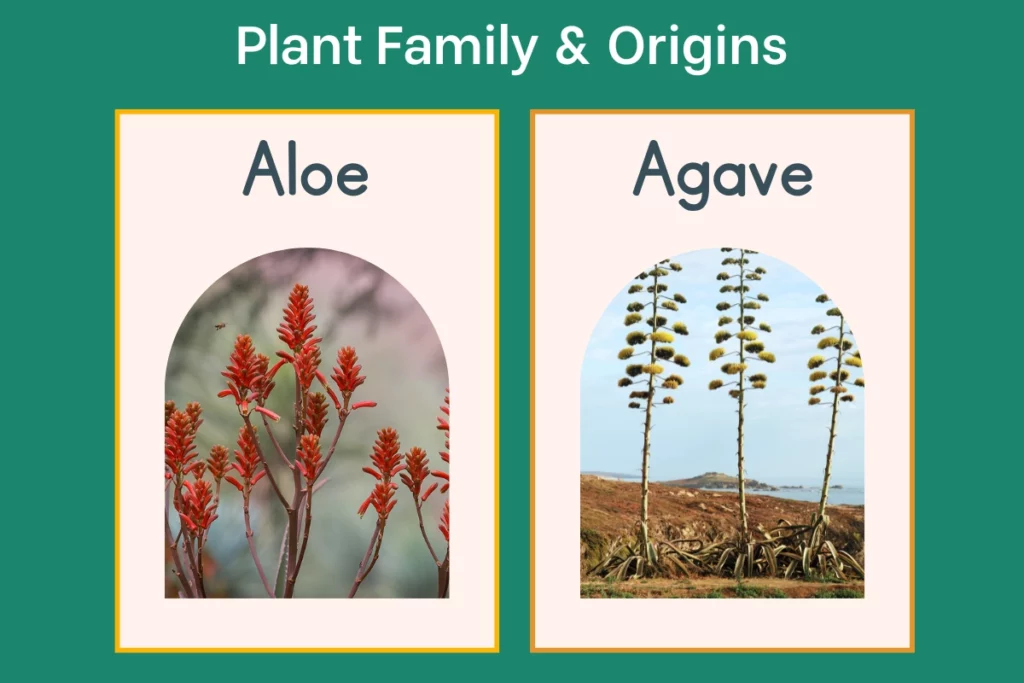
They belong to different plant families, which affects everything from leaf structure to blooming behavior. Their similarity is due to convergent evolution, as both have adapted to arid climates in different parts of the world.
Leaf Texture
- Aloe leaves are soft, juicy, and easy to snap or bend. You can almost squeeze them like a gel pack. They store water efficiently to survive dry periods and feel smooth and fleshy when touched.
- Agave leaves are firm, dry, and often stiff like cardboard. They’re built to be tough, sometimes with waxy or leathery surfaces that reduce moisture loss.
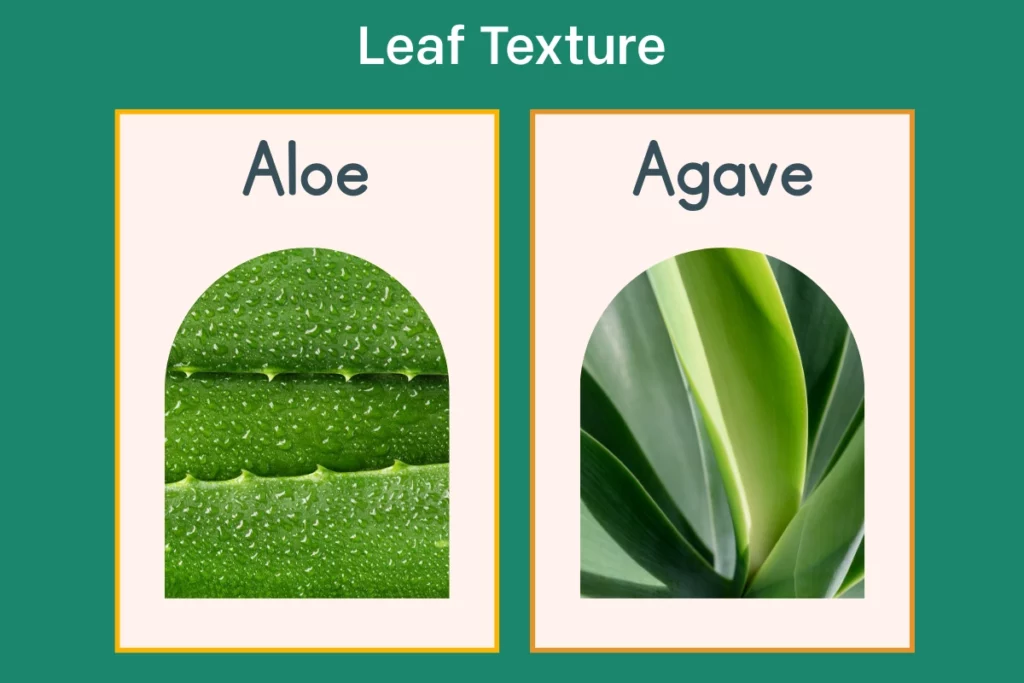
A good rule: if the leaf feels flexible and “alive,” it’s likely aloe. If it feels tough or armor-like, it’s probably agave.
Leaf Edge and Tip
- Aloe has small, soft, or rubbery teeth along the leaf margin. They might look sharp, but most are harmless.
- Agave leaves are more weapon-like. The edges often have rigid spines, and the tip usually ends in a very sharp point, some of which are sharp enough to pierce skin or even clothing.

Interior Sap
This difference is both practical and vital.
- Aloe vera contains a clear, slippery gel well known for its soothing, skin-healing properties.
- Agave produces a milky or watery sap, which can be irritating or even toxic on contact. It’s not suitable for skin care, and some species can cause rashes or burns.

Growth Pattern & Lifespan
- Aloe grows as a perennial, forming clumps and producing new leaves continuously. A healthy aloe can live for many years and can be propagated easily through offsets.
- Agave follows a monocarpic lifecycle. It grows for years or even decades, then sends up a tall flower stalk, blooms once, and dies. Some agave species produce “pups” (offsets) to continue the lineage, but the mother plant won’t survive.
This difference makes a big impact on gardens. If your plant flowered and is now declining, it’s almost certainly an agave.
Flowering Behavior
- Aloe blooms regularly, even indoors with enough light. The flowers appear on short stalks and come in colors like yellow, orange, or red.
- Agave puts all its energy into one dramatic bloom — usually a towering stalk several feet tall — then declines and dies. Depending on the species, this can happen after 8 to 30 years.
If you’ve seen a plant with a bloom taller than you, growing from the center, chances are, it was an agave.
Common Uses
- Aloe vera is widely used in skincare products, health drinks, and home remedies. It’s also one of the most popular succulents for indoor growing.
- Agave is best known for producing tequila (from Agave tequilana), agave syrup, and durable fibers. In landscaping, it’s valued for its sculptural look and drought resistance, but not for topical use.
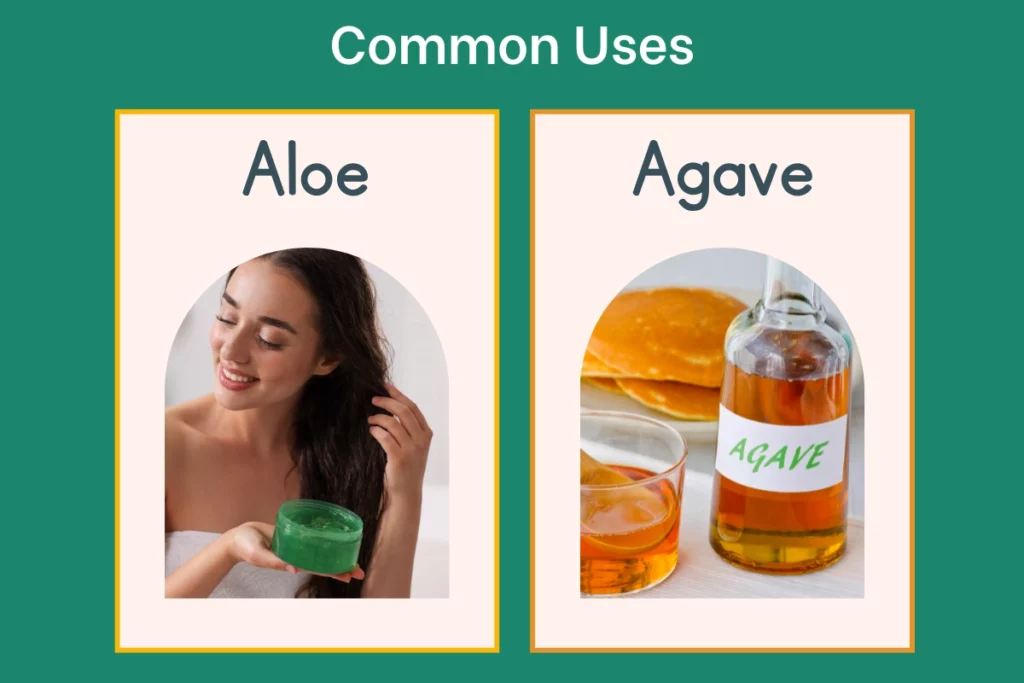
Agave vs Aloe Plants: Common Species
There are hundreds of aloe and agave varieties, but only a few are commonly seen in gardens or homes. Here are some of the most recognizable ones. Knowing these can make agave vs aloe plants much easier to tell apart.
Common Aloe Species
Aloe vera is the most well-known, thanks to its clear, soothing gel. It grows in a rosette with bright green or grey-green leaves edged by soft teeth. You’ll often see it in pots or garden beds, especially near kitchens or patios, for quick use on burns.
Aloe aristata, also known as lace aloe, is compact with dark green, spotted leaves and white, soft edges. Its rosette shape and curved leaves make it a favorite in containers. It can be mistaken for Haworthia but blooms with small reddish-orange flowers.
Aloe brevifolia, or short-leaf aloe, has thick, triangular, blue-green leaves and forms tight clumps. In full sun or drought, it takes on a reddish tint. It’s a hardy ornamental plant, often found in borders or rock gardens.
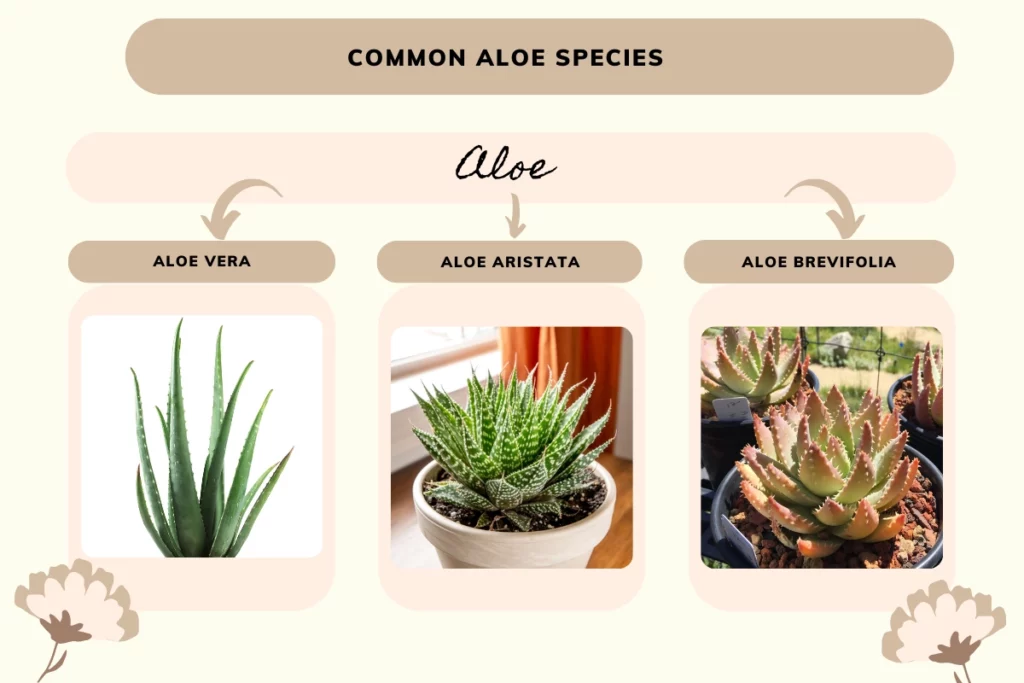
Common Agave Species
Agave americana (century plant) is a large and dramatic plant, with blue-gray leaves that can reach several feet in length. The edges and leaf tips are armed with sharp spines, and it sends up a towering flower stalk only once before it dies. Its sap can irritate skin.
Agave attenuata is a softer-looking plant, characterized by smooth-edged, pale green leaves that curve gracefully. Known as foxtail agave, it has no sharp terminal spine, making it safer for gardens and walkways. Its flowering stalk arches like a plume.
Agave parryi, also known as artichoke agave, is a compact and sculptural plant. Its short, broad, blue-grey leaves form a symmetrical rosette with dark, pointed tips. It’s also more cold-tolerant than many agaves, making it popular in cooler desert climates.
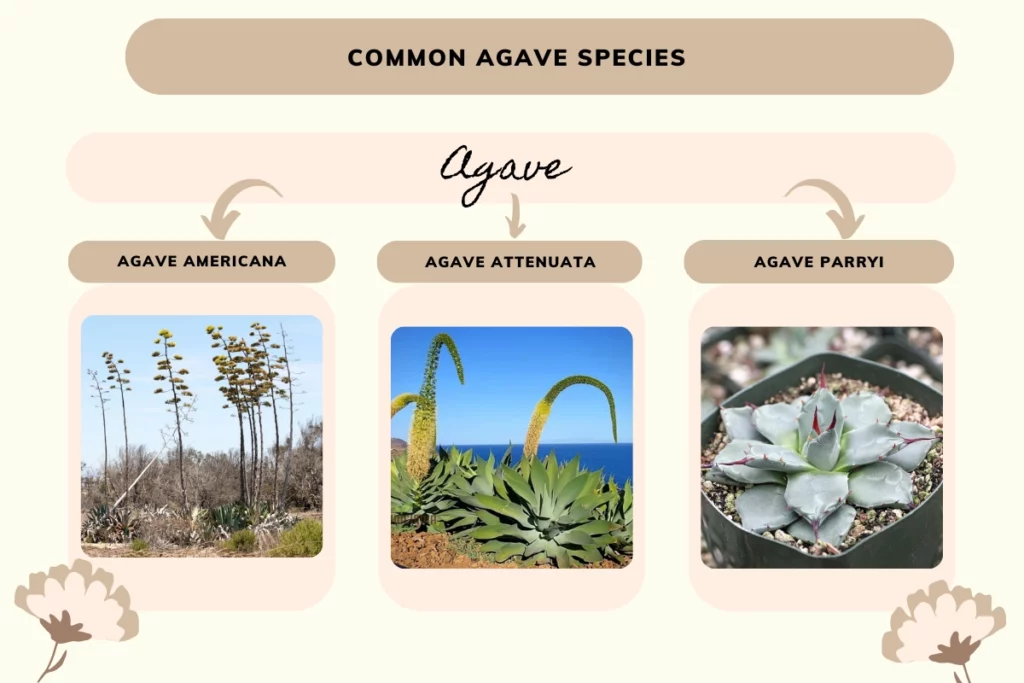
Best Tools to Identify Aloe vs. Agave
Not sure whether you’re looking at aloe or agave? These tools can help you make an accurate call, especially when you’re dealing with young plants, hybrids, or unfamiliar varieties.
- Planteyes – The most accurate app for distinguishing aloe vs. agave using photo-based plant identification.
- Google Lens – Quick and convenient, but results can be inconsistent with lookalike succulents.
- Field guides – Useful for outdoor identification in native regions like the Southwest; best for hikers and enthusiasts.
- Online plant forums – Great for second opinions; post a photo and get feedback from experienced plant owners.
- Nursery or garden center staff – If you purchased the plant locally, asking the seller can often provide a reliable answer.
Conclusion
At first glance, aloe and agave may look similar, but once you know what to observe, the differences are apparent. From leaf texture and sap type to blooming behavior and long-term care, these two plants serve distinct purposes and exhibit different growth patterns. If you’re unsure what you’re looking at, don’t guess. Use the Planteyes app to identify aloe vs. agave in seconds. It’s fast, reliable, and helps you avoid care mistakes or misuse.
FAQs
Are agave and aloe vera the same?
No. Aloe vera is used for skin care; agave is not. Agave sap can irritate skin and should not be used as a substitute.
What’s the quickest way to tell aloe vs. agave apart?
Check the sap, leaf texture, and spines. Aloe is soft and juicy; agave is rigid and sharp.
Can I grow aloe vs. agave indoors?
Yes, but aloe adapts better to indoor conditions. Most agaves prefer outdoor, full-sun environments.
How can Planteyes help in identifying aloe vs. agave?
Just take a photo. Planteyes identifies the plant and tells you whether it’s aloe, agave, or something else entirely.


